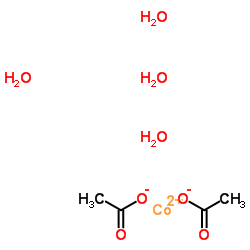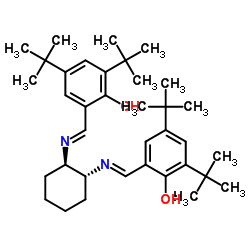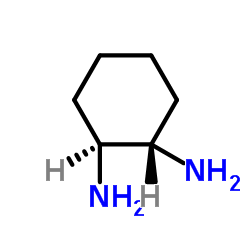(R,R)-(-)-N,N'-Bis(3,5-di-tert-butylsalicylidene)-1,2-cyclohexanediaminocobalt(II)

(R,R)-(-)-N,N'-Bis(3,5-di-tert-butylsalicylidene)-1,2-cyclohexanediaminocobalt(II) structure
|
Common Name | (R,R)-(-)-N,N'-Bis(3,5-di-tert-butylsalicylidene)-1,2-cyclohexanediaminocobalt(II) | ||
|---|---|---|---|---|
| CAS Number | 176763-62-5 | Molecular Weight | 605.759 | |
| Density | N/A | Boiling Point | N/A | |
| Molecular Formula | C36H52CoN2O2 | Melting Point | >350ºC(lit.) | |
| MSDS | Chinese USA | Flash Point | N/A | |
| Symbol |

GHS07 |
Signal Word | Warning | |
| Name | (R,R)-(-)-N,N'-Bis(3,5-di-tert-butylsalicylidene)-1,2-cyclohexanediaminocobalt(II) |
|---|---|
| Synonym | More Synonyms |
| Melting Point | >350ºC(lit.) |
|---|---|
| Molecular Formula | C36H52CoN2O2 |
| Molecular Weight | 605.759 |
| Exact Mass | 605.351746 |
| PSA | 43.18000 |
| LogP | 8.28320 |
|
Section 1: Product Identification Chemical Name:(1R,2R)-(-)-1,2-Cyclohexanediamino-N,N'-bis(3,5-di-t-butylsalicylidene)cobalt (II) CAS Registry Number:176763-62-5 Formula:C36H52CoN2O2 EINECS Number:none Chemical Family:organometallic complexes Synonym:none
Section 2: Composition and Information on Ingredients IngredientCAS NumberPercentACGIH (TWA)OSHA (PEL) Title Compound176763-62-5100%0.02mg/m3 (as Co)no data Section 3: Hazards Identification Causes irritation of eyes, skin, and respiratory tract. May cause lung disease, polycythemia, congestive failure, Emergency Overview: and enlargement of the thyroid. Limited evidence of a carcinogenic effect. Primary Routes of Exposure:Skin and eyes, ingestion and dust inhalation. Eye Contact:Causes irritation, redness, and pain. Skin Contact:May cause dermatitis. Causes irritation to skin. Symptoms include redness, itching, and pain. Causes irritation to the respiratory tract. Symptoms may include coughing, shortness of breath, nausea, Inhalation: respiratory hypersensitivity, asthma. Causes abdominal pain, nausea, vomiting, flushing of the face and ears, mild hypo tension, rash, and ringing Ingestion: in the ears. Irritating to skin, eyes and respiratory tract. Causes abdominal pain, nausea, vomiting, coughing, and Acute Health Affects: shortness of breath. Repeated oral administration of cobalt salts may reduce thyroid activity, cause blood disease, and damage Chronic Health Affects:kidney, heart and lungs. Prolonged or repeated skin exposure may cause dermatitis. Limited evidence of a carcinogenic effect. NTP:No IARC:No OSHA:No SECTION 4: First Aid Measures Immediately flush the eyes with copious amounts of water for at least 10-15 minutes. A victim may need Eye Exposure: assistance in keeping their eye lids open. Get immediate medical attention. Wash the affected area with water. Remove contaminated clothes if necessary. Seek medical assistance if Skin Exposure: irritation persists. Remove the victim to fresh air. Closely monitor the victim for signs of respiratory problems, such as difficulty Inhalation: in breathing, coughing, wheezing, or pain. In such cases seek immediate medical assistance. Seek medical attention immediately. Keep the victim calm. Give the victim water (only if conscious). Induce Ingestion: vomiting only if directed by medical personnel. SECTION 5: Fire Fighting Measures Flash Point:not applicable Autoignition Temperature:none Explosion Limits:none Extinguishing Medium:carbon dioxide, foam or dry powder If this product is involved in a fire, fire fighters should be equipped with a NIOSH approved positive pressure Special Fire Fighting Procedures: self- contained breathing apparatus and full protective clothing. Hazardous Combustion andIf involved in a fire this material may emit toxic organic fumes. Decomposion Products: Unusual Fire or Explosion Hazards: No unusual fire or explosion hazards. SECTION 6: Accidental Release Measures Small spills can be mixed with vermiculite, sodium carbonate or other suitable non combustible adsorbent and Spill and Leak Procedures: swept up. SECTION 7: Handling and Storage Handling and Storage:Store in a tightly sealed container away from heat and direct sunlight. SECTION 8: Exposure Controls and Personal Protection Eye Protection:Always wear approved safety glasses when handling a chemical substance in the laboratory. Skin Protection:Wear protective clothing and gloves. Ventilation:Material may form a fine dust. If possible, handle the material in an efficient fume hood. If ventilation is not available a respirator should be worn. The use of respirators requires a Respirator Respirator: Protection Program to be in compliance with 29 CFR 1910.134. Ventilation:Material may form a fine dust. If possible, handle the material in an efficient fume hood. Additional Protection:No additional protection required. SECTION 9: Physical and Chemical Properties Color and Form:red-brown pwdr. Molecular Weight:603.76 Melting Point:406-412°C Boiling Point:no data Vapor Pressure:not applicable Specific Gravity:no data Odor:none Solubility in Water:insoluble SECTION 10: Stability and Reactivity Stability:air and moisture stable Hazardous Polymerization:no hazardous polymerization Conditions to Avoid:none Incompatibility:oxidizing agents Decomposition Products:carbon dioxide, carbon monoxide, nitrogen oxides, organic fumes, and cobalt oxide. SECTION 11: Toxicological Information RTECS Data:No information available in the RTECS files. Carcinogenic Effects:Possible carcinogen Mutagenic Effects:No data Tetratogenic Effects:No data SECTION 12: Ecological Information Ecological Information:No information available SECTION 13: Disposal Considerations Disposal:Dispose of according to local, state and federal regulations. SECTION 14: Transportation Shipping Name (CFR):Non-hazardous Hazard Class (CFR):NA Additional Hazard Class (CFR):NA Packaging Group (CFR):NA UN ID Number (CFR):NA Shipping Name (IATA):Non-hazardous Hazard Class (IATA):NA Additional Hazard Class (IATA):NA Packaging Group (IATA):NA UN ID Number (IATA):NA SECTION 15: Regulatory Information TSCA:Not listed in the TSCA inventory. SARA (Title 313):Title compound: See category N096 for reporting. Second Ingredient:None SECTION 16 - ADDITIONAL INFORMATION N/A |
| Symbol |

GHS07 |
|---|---|
| Signal Word | Warning |
| Hazard Statements | H302-H312-H332 |
| Precautionary Statements | P280 |
| Personal Protective Equipment | dust mask type N95 (US);Eyeshields;Gloves |
| Hazard Codes | Xn: Harmful; |
| Risk Phrases | R20/21/22 |
| Safety Phrases | 36/37/39 |
| RIDADR | NONH for all modes of transport |
| WGK Germany | 3 |
|
~96% 
(R,R)-(-)-N,N'-... CAS#:176763-62-5 |
| Literature: Schaus, Scott E.; Brandes, Bridget D.; Larrow, Jay F.; Tokunaga, Makoto; Hansen, Karl B.; Gould, Alexandra E.; Furrow, Michael E.; Jacobsen, Eric N. Journal of the American Chemical Society, 2002 , vol. 124, # 7 p. 1307 - 1315 |
|
~98% 
(R,R)-(-)-N,N'-... CAS#:176763-62-5 |
| Literature: Chapman; Day; Welker Organometallics, 2000 , vol. 19, # 9 p. 1615 - 1618 |
|
~80% 
(R,R)-(-)-N,N'-... CAS#:176763-62-5 |
| Literature: Rhodes, Barry; Rowling, Simon; Tidswell, Peter; Woodward, Simon; Brown, Stephen M. Journal of Molecular Catalysis A: Chemical, 1997 , vol. 116, # 3 p. 375 - 384 |
|
Asymmetric catalysis with water: efficient kinetic resolution of terminal epoxides by means of catalytic hydrolysis.
Science 277 , 936, (1997) Epoxides are versatile building blocks for organic synthesis. However, terminal epoxides are arguably the most important subclass of these compounds, and no general and practical method exists for the... |
|
|
Jacobsen, E.N. et al.
Tetrahedron Lett. 38 , 773, (1997)
|
| 2,2'-{(1R,2R)-1,2-Cyclohexanediylbis[nitrilo(E)methylylidene]}bis[4,6-bis(2-methyl-2-propanyl)phenol] - cobalt (1:1) |
| (R,R)-(-)-N,N′-Bis(3,5-di-tert-butylsalicylidene)-1,2-cyclohexanediaminocobalt(II) |
| Phenol, 2,2'-[(1R,2R)-1,2-cyclohexanediylbis[nitrilo(E)methylidyne]]bis[4,6-bis(1,1-dimethylethyl)-, cobalt salt (1:1) |
| MFCD01631277 |
| (R,R)-(-)-N,N'-BIS(3,5-DI-TERT-BUTYLSALICYLIDENE)-1,2-CYCLOHEXANEDIAMINO-COBALT(II) |

![(1R,2R)-1,2-Bis[[[3,5-bis(tert-butyl)-2-hydroxyphenyl]methylene]amino]cyclohexane structure](https://image.chemsrc.com/caspic/241/151433-25-9.png)


